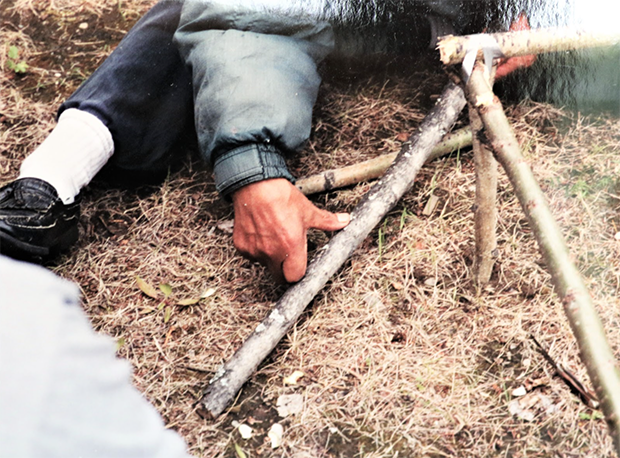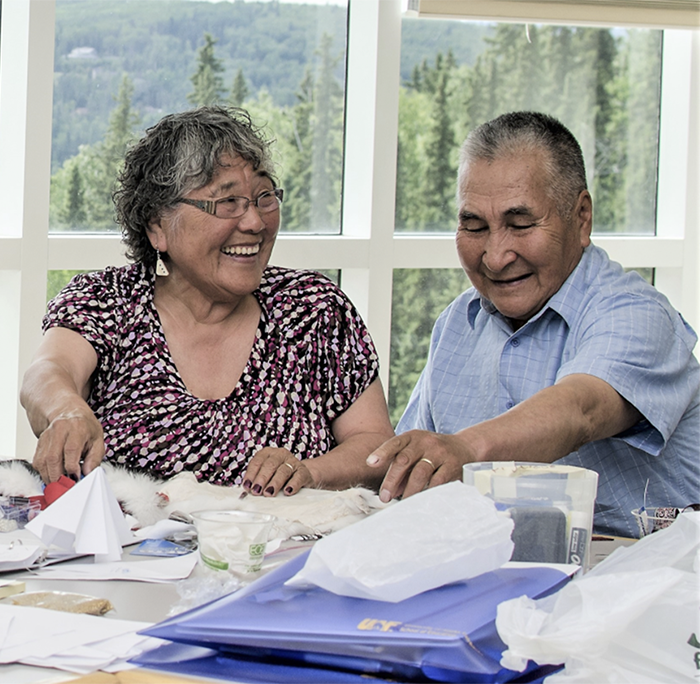Meet the Elders
Under Construction
We are currently working to update and expand this section to include more photos, information, and additional elders that contributed their invaluable knowledge to MCC. The map and inset represent the communities where Yupiaq Eskimo Knowledge holders
contributed to the work of MCC.
The map and inset represent the communities where Yupiaq Eskimo Knowledge holders
contributed to the work of MCC.
Mary Active
Togiak
Evelyn Yanez introduced Mrs. Active to our project. Mrs. Active was from Togiak, Alaska and was known for her storytelling skills and many of her stories were recorded, transcribed, and translated. Beyond her knowledge of stories and storytelling, she understood a way to create geometric shapes without using Western technology. Her method of creating a 5-pointed star, shown In the accompanying photograph, puzzled the math educators who were observing her. As the “ah ahs” were vocalized and the math educators began understanding her way of constructing the 5-pointed star. As the project developed, we realized that Mrs. Active’s method was fundamentally the same as number of the Elders in the project and that it was a generalized way to construct a variety of geometric shapes and a way to physically construct rational numbers. At left, Mrs. Active demonstrates how to make a 5-pointed star to teachers, math educators, and is assisted by Evelyn Yanez (center).

Henry Alakayak
Manokotak

He was born in 1929 in beautiful Kulukak and passed away in 2013 at age 84. He lived most of his life in Manokotak, Alaska asa commercial fisherman, subsistence hunter, a leader in the Moravian Church, and involved in teaching young people Yupiaq skills and knowledge. Henry fully embraced Math in a Cultural Context (MCC). He quickly took on a leadership role in the MCC program. He worked with classroom teachers during MCC’s Summer Math Institutes teaching them and everyone else humility, harmony, and Yup’ik cultural knowledge. When the program was introduced to Yup’ik communities unfamiliar with MCC, Henry would be the person to address the community. Henry and Jerry Lipka worked and traveled together for more than fifteen years. Henry wondered how Yup’ik ways of life would have developed if not influenced by the dominant Western society. He called Lipka a helper and the importance of that role by an “outsider.” Henry wanted his knowledge to go forward into the future. He believed if we were of “one mind” we accomplish our goals. Henry was a poetic philosopher and he displayed this when we worked with teachers during the Summer Math Institute.

Henry Alakayak positions a teacher, a community member, and a math educator as the four corner posts of a fish rack according to his Yup’ik values of cooperation and interdependence. All of us were needed to keep the structure stable and working.

Henry and Anecia create a counting activity.
Henry Alakayak and his sister Anecia Lomack creating a counting activity using the
Yupiaq drum. This was significant since the village of Manokotak was banned from using
the drum by the Moravian Church. Without hesitation, Henry and Anecia began creating
a rhythm.

Dora Andrew-Ihrke
Dillingham

Dora Andrew-Ihrke has been a bilingual aid, classroom teacher, and program coordinator of the bilingual/bicultural education program at Dillingham City Schools. She was recognized by the larger educational community: 1985 a recipient of Dillingham City Schools’ Excellence in Teaching, 1990 a Milken Educator Award and Alaska Teacher of the Year, and a 2001 recipient of the Alaska Federation of Natives education award. She became a faculty member at the University of Alaska Fairbanks, School of Education in the Math in a Cultural Context (MCC) program. Dora was raised by her parents Annie and Fred Andrew and her grandmother who lived a subsistence lifestyle. Beginning in her childhood she was immersed in the Elders’ Yupiaq culture and she has worked with Elders ever since. MCC benefited greatly from her knowledge as she shared the lessons learned from her close relatives. In particular, Annie Andrew, Dora’s mother, taught her how to construct geometric shapes. Through many years of working collaboratively with Dora we realized that her method of constructing geometric shapes was generalizable. Underlying the process of constructing geometrical shapes were a set of interconnected mathematical concepts. This knowledge was critical to developing a cohesive way to teach the fundamentals of mathematics.
Annie Blue
Togiak
The late Annie Blue, a revered elder and wonderful storyteller from Togiak, Alaska, continues to contribute to the Math in a Cultural Context (MCC) series and to the next generation through the stories she told. Annie Blue passed away at her home in Togiak in 2016 at age 97. Annie’s deep cultural knowledge, dedication and caring attitude were recognized by the University of Alaska Fairbanks in 2009 when she was awarded an honorary doctorate.

Annie Blue Greeting the Sun, at MCC's Summer Math Institute in 2008.

Annie Blue and daughter Nellie receiving her Honorary Doctorate.

Honoring Annie Blue. Dora Andrew-Ihrke laughing on the left, and Evelyn on her knees on the right side.

From left to right are Joshua Phillip, Henry Alakayak, and Mary George demonstrating the Yupiaq counting system. Many Elders explored the Yupiaq counting system.
Joshua Phillip
Akiachak
Joshua Phillip, a respected and knowledgeable elder, shared knowledge about weather predictions, making fish traps, and Yup’ik medicine.

Fred George's beautiful fish trap.
Fred and Mary George
Akiachak
Fred and Mary George contributed to MCC in many ways. Fred was creative, resourceful, a problem-solver, and a kind human being. He was rich in traditional knowledge. Mary was an outstanding creative teacher; a wonderful storyteller and a delight to work with.

Fred George demonstrating star navigation to Nastasia Wahlberg and Henry Alakayak.

Mary George at Fish Camp, showing salmon roe.

Nick Gumlickpuk
New Stuyahok

Nick Gumlickpuk lived in New Stuyahok and he was well steeped in traditional knowledge. Just as importantly, Nick had an incredible warmth and an infectious smile and laugh. He liked to tell traditional and string stories which were always enjoyed by the group. In the photograph to the right, he is sharing his method of constructing snowshoes with Dora Andrew-Ihrke and the group.
Raphael and Vivian Jimmy
Mountain Village

The late Mr. Jimmy, a relative newcomer to the project, was a tireless worker who cared deeply for culture and the next generation. During one meeting, Mr. Jimmy slowly and dramatically raised his two index fingers, crossing them to form a plus sign “+”. He told our long-term group of Yup’ik elders and academics that, “this is the center of everything." This moment stands out as an epiphany of our time working together to understand how Yupiaq and other elders perform a wide array of everyday activities from making clothing to navigating on land in the sea.
Anuska Nanalook
Manokotak

Mrs. Nanalook was steadfast; she worked with us from the very first meetings in the late 80s to the close of the project(30+ years). She always shared her knowledge of basket weaving and making clothing and patterns as well as her intellectual knowledge on the thoughts behind those processes. At left, she demonstrates how to start weaving a grass basket.
 Sassa Peterson
Sassa Peterson
Sassa Peterson has been a bilingual aide and classroom teacher as well as bilingual/multi-cultural
Mike and Anecia Toyukak
Manokotak

Mike and Anecia Toyukak began working with us at the start of the project in the 80’s and were steadfast, coming to countless meetings. They shared deep cultural knowledge. Mike shared his knowledge of travel/navigating on land; place names; net mending. Mike shared knowledge (and his understanding behind it) with us that Jerry is still unable to fully understand. Anecia was an expert bilingual instructor in the Manokotak school; a phenomenal and creative teacher. She taught through the Yup'ik Language and she shared her knowledge of constructing all kinds of things (baskets, clothing, dolls, telling stories, storyknifing).

Eva Evelyn Yanez
Togiak
Eva Evelyn Yanez, a former Yup’ik teacher and state-recognized bilingual educator, has been involved in education for over 40 years. As a youngster she often listened to Annie Blue, renowned storyteller, who told traditional stories and storyknifing. As a classroom teacher, bilingual coordinator of Southwest Region Schools, and as Yup’ik language consultant to the village of Igiugig she has recorded, transcribed, and translated traditional stories. Many of these stories have been published. During her many years with MCC she would translate at meetings with Yupiaq Elders and nonYup’ik speakers. Her knowledge of craft making and analysis of the process helped all of see the underlying structure across many Yupiaq everyday activities.







